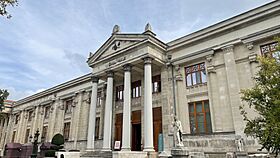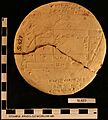Istanbul Archaeology Museums facts for kids
| İstanbul Arkeoloji Müzeleri | |

Entrance gate of the Archaeological Museum
|
|
| Established | 13 July 1891 |
|---|---|
| Location | Osman Hamdi Bey Yokuşu Sokak, Gülhane, Istanbul, Turkey |
| Type | Archaeology museum |
| Collection size | Approx. 1 million objects |
| Visitors | 382.148 (2011) |
| Founder | Osman Hamdi Bey |
The Istanbul Archaeology Museums (Turkish: İstanbul Arkeoloji Müzeleri) are a super cool group of three museums in Istanbul, Turkey. They are located near Gülhane Park and Topkapı Palace. These museums are like giant treasure chests, holding over one million amazing objects! These items come from almost every time period and civilization in world history. Imagine seeing things from ancient Egypt, mighty Rome, and many other fascinating cultures all in one place!
Contents
What Are These Museums?
The Istanbul Archaeology Museums are actually three different museums, each with its own special focus:
- Archaeological Museum: This is the main museum, found in the biggest building. It's full of ancient artifacts.
- Museum of the Ancient Orient: This museum shows off items from ancient lands in the Middle East.
- Museum of Islamic Art: This museum is inside a beautiful old building called the Tiled Kiosk. It displays art from Islamic cultures.
A Look Back in Time: How it Started
The story of these museums began a long time ago, near the Hagia Irene Church. After Istanbul was conquered, this church became a place to store weapons for soldiers called Janissaries. It was like an "inner arsenal" for their gear.
By 1726, during the time of Sultan Ahmed III, it was known as the Dar-ül Esliha, which means "House of Weapons." As time went on, the church also started to store many old objects collected by the Ottoman Empire.
Sultan Abdülaziz visited famous museums in Paris, London, and Vienna in 1867. He was so impressed that he ordered a similar museum to be built in Istanbul. So, in 1869, the church and its collection were officially opened as the Imperial Museum. Because of this, the Istanbul Archaeology Museum is often called the "first museum of Turkey."
The Museum's Journey

The museum's collection grew so much that there wasn't enough room! So, between 1875 and 1891, the museum and its treasures moved to the Tiled Kiosk. This beautiful building was built in 1472 by Sultan Mehmed II as a fancy palace for fun. It's the oldest non-religious Ottoman building in Istanbul and still shows clear Persian style. It first opened to the public in 1953 to show Turkish and Islamic art, and later became part of the Istanbul Archaeology Museum.
Meet Osman Hamdi Bey
In 1881, a very important person named Osman Hamdi Bey became the first person in charge of the museum's collection, also known as its founder. He was a talented painter and archaeologist. His father was a very important government official in the Ottoman Empire. Osman Hamdi Bey was such a skilled artist that in 2019, one of his paintings sold for a huge amount of money, making it the most expensive Turkish painting at that time.
Protecting Old Treasures
During the 1800s, people in the Ottoman Empire started to realize how important old artifacts were, just like in Europe. This led to questions about how to protect and manage these old treasures. Before this, there weren't clear rules for preserving historical items.
This changed in 1869 when the first laws were made about old objects. These laws focused on giving permission for digging up old sites and handling what was found. According to these early laws, if you owned land where an excavation happened, you could keep what was discovered. It was against the law to take these old items out of the country, but they could be bought and sold within the Ottoman Empire. The government had the first right to buy them. With this royal order to protect cultural goods, governors from all over the Ottoman Empire sent any old items they found to Istanbul, making the museum's collection even bigger.
Building the Main Museum
Soon, many more big discoveries were made, like an ancient cemetery of a king in modern-day Lebanon. It became clear that a building made just for the museum was needed to hold the growing collection.
The construction of the main museum building began in 1881, led by Osman Hamdi Bey. It officially opened on June 13, 1891. The architect, Alexander Vallaury, also designed the famous Pera Palace Hotel in Istanbul. The front of the museum building was inspired by two famous ancient coffins, the Alexander Sarcophagus and the Sarcophagus of the Mourning Women, which are both inside the museum! The writing on the front of the museum says "Museum of Antiquities" in Ottoman Turkish. The special symbol on the inscription belongs to Sultan Abdulhamid II. Many people think this building is a top example of a special building style called Neoclassical architecture in Istanbul. In 1991, on its 100th birthday, the museum won a special award from the European Council for its great renovations and new displays.
The Ancient Orient Museum
The Museum of the Ancient Orient was first planned by Osman Hamdi Bey in 1883 as an art school. It was later changed into a museum and opened in 1935. This museum has collections from ancient Anatolia (modern-day Turkey) and other places like Mesopotamia, Egypt, Syria, and Iran.
For example, it has about 1,200 items showing different kinds of Egyptian art. Many of these were found during digs near Karnak in 1891. Others were gifts from Egyptian rulers and Ottoman officials. There are also 10,000 items from Mesopotamia, found in ancient cities like Assur and Nineveh. Objects from ancient Palestine came from places like Gezer and Jericho. Some vases from Susa were bought from French archaeologists.
Amazing Things You Can See
The museum has a huge collection of Turkish, ancient Greek, and Roman artifacts. Many of these were gathered from the vast lands that used to be part of the Ottoman Empire. Here are some of the most famous and interesting items you can see:
- Ornate Sarcophagi: These are beautifully decorated ancient coffins from an ancient cemetery in Sidon.
- The Alexander Sarcophagus: This is one of the most famous pieces of ancient art in the museum. People once thought it was made for Alexander the Great himself!
- The Sarcophagus of the mourning women: Another amazing coffin from Sidon.
- The Tabnit sarcophagus and the Lycian sarcophagus of Sidon: More incredible ancient coffins.
- Glazed Tile Images: These colorful tiles come from the famous Ishtar Gate of Babylon.
- Ancient Statues: You can see statues from ancient times all the way to the end of the Roman Era, found in places like Aphrodisias and Ephesus.
- Statue of an Ephebos: A statue of a young man.
- Statue of Apollo Citharoedus: A statue of the Greek god Apollo playing a lyre.
- Parts of the Pergamon Altar: Pieces from the ancient Temple of Zeus found in Pergamum.
- Marble Lion: One of the few pieces remaining in Turkey from the Mausoleum of Mausolus, one of the Seven Wonders of the Ancient World.
- Snake's Head: From the Serpentine Column that once stood in the Hippodrome of Constantinople.
- Mother-Goddess Cybele: Statues and carvings of an ancient goddess.
- Busts of Alexander the Great and Zeus: Head and shoulder sculptures of these famous figures.
- The Troy Exhibit: Items from the legendary city of Troy.
- Old Coins and Medals: A collection of 800,000 Ottoman coins, seals, and decorations.
- Oldest Law-Collection: A tablet with the oldest known set of laws, from King Ur-Nammu.
- World's Oldest Peace Treaty: Two of the three tablets of the Egyptian–Hittite peace treaty (from 1258 BCE). This treaty was signed between Ramesses II of Egypt and Hattusili III of the Hittite Empire. A giant poster of these tablets is even on the wall of the United Nations Headquarters in New York City!
- Cuneiform Tablets: An archive of about 75,000 documents written in cuneiform (an ancient writing system). This includes a tablet with the oldest known love poem!
- Siloam inscription: An important ancient inscription.
- Gezer calendar: An ancient Hebrew inscription.
Gallery
-
Si.427 obverse, an ancient clay tablet from the Old Babylonian period.
-
The famous Alexander Sarcophagus, found in Sidon.
-
An icon with a relief of the Virgin Mary praying.
-
A statue of Emperor Valentinian II.
-
A statue of Alexander the Great.
-
Puzur Ishtar, an ancient governor of Mari.
-
A glazed brick panel from the way to the Ishtar Gate.
-
Porphyry sarcophagi of Byzantine emperors.
-
A piece of a Byzantine sarcophagus, possibly belonging to Constantine the Great.
See also
- Great Palace Mosaic Museum
- Museum of Anatolian Civilizations
- Turkish and Islamic Arts Museum

















